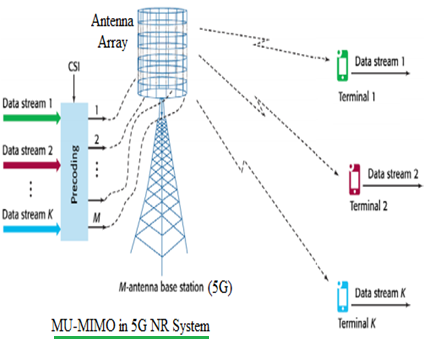This page compares SU-MIMO vs MU-MIMO and mentions difference between SU-MIMO and MU-MIMO with respect to 802.11ax (wifi6), 4G/LTE and 5G NR (New Radio) technologies.
Introduction : MIMO refers to multiple input multiple output. It basically refers to system having more than one antenna elements used either to increase system capacity, throughput or coverage. Beamforming techniques are used to concentrate radiated energy towards target UE which reduces interference to other UE’s and thereby improves the coverage.
There are two major types of MIMO with respect how the BS (Base Station) transmission is utilized by the mobile or fixed users. They are SU-MIMO and MU-MIMO. Both the types are used in the downlink direction i.e. from Base Station or eNB or Access point towards users.
There is another concept called massive MIMO or mMIMO in which combines multiple radio units and antenna elements on single active antenna unit. It houses 16/32/64/96 antenne elements. The massive MIMO employs beamforming which directs energy in desired user direction which reduces interference from undesired users.
SU-MIMO
• In SU-MIMO, all the streams of antenna arrays are focused on single user.
• Hence it is referred as Single User MIMO.
• It splits the available SINR between different multiple data layers towards target UE simultaneously where each layer is separately beamformed. This increases peak user throughput and system capacity.
• Here cell communicates with single user.
• Advantages : No interference

The figure depicts SU-MIMO and MU-MIMO concept in IEEE 802.11ax (wifi6) system. It shows wifi6 compliant AP (Access Point) and wifi6 stations or users or clients.
MU-MIMO
• In MU-MIMO, multiple streams are focused on multi users. Moreover each of these streams provide radiated energy to more than one users.
• Hence it is referred as Multi User MIMO.
• It shares available SINR between multiple data layers towards multiple UEs simultaneously where each layer is separately beamformed. This increases system capacity and user perceived throughput.
• Here cell communicates with multi users.
• Advantages : Multiplexing gain

The figure depicts MU-MIMO used in mMIMO system in 5G. As shown multiple data streams (of multiple users) are passed through layer mapping/precoding before they are being mapped to antenna array elements and transmitted over the air.
Tabular difference between SU-MIMO and MU-MIMO
Following table summarizes difference between SU-MIMO and MU-MIMO.
| Features | SU-MIMO | MU-MIMO |
|---|---|---|
| Full Form | Single User MIMO | Multi User MIMO |
| Function | It is the mechanism in which information of single user is transmitted simultaneously over more than one data stream by BS (Base Station) in same time/frequency grid (i.e. resources). | In MU-MIMO, data streams are distributed across multiple users on same time/frequency resources but dependent upon spatial separation. |
| Major Objective | It helps in increasing user/link data rate as it is function of bandwidth and power availability. | It helps in increasing system capacity i.e. number of users supported by base station. |
| Performance impact (Antenna Correlation) | More susceptible | Less susceptible |
| Performance Impact (Source of interference) | Adjacent co-channel cells | Links supporting same cell and other MU-MIMO users, and adjacent co-channel cells |
| Power allocation | Split between multiple layers to same user. Fixed per transmit antenna | Shared between multi-users and multiple layers. It can be allocated per MU-MIMO user based on channel condition. |
| CSI/Feedback process | Varies upon implementation, TDD or FDD and reciprocity or feedback based. Less susceptible on feedback granularity and quality | Very dependent upon CSI for channel estimation accuracy. More susceptible on feedback granularity and quality |
| Beamforming dependency | Varies upon implementation TDD or FDD and reciprocity or feedback based. Less susceptible on feedback granularity and quality | Greatly assisted by appropriate beamforming mechanisms (spatial focusing) which maximizes gain towards the intended users. More susceptible on feedback granularity and quality |
WLAN 802.11ax related links
802.11n versus 802.11ax
802.11ac versus 802.11ax
Advantages and disadvantages of 802.11ax
BSS coloring in 11ax
RU in 802.11ax
MU-OFDMA in 802.11ax
MU-MIMO in 802.11ax
TWT power save mode in 802.11ax
5G NR Numerology | 5G NR Terminology
5G TECHNOLOGY RELATED LINKS
This 5G tutorial also covers following sub topics on the 5G technology:
5G basic tutorial 5G Frequency Bands 5G millimeter wave tutorial 5G mm wave frame 5G millimeter wave channel sounding Difference between 4G and 5G 5G testing and test equipments 5G network architecture 5G network slicing 5G TF vs 5G NR 5G NR Physical layer 5G NR MAC layer 5G NR RLC layer 5G NR PDCP layer
What is Difference between
difference between 3G and 4G difference between 4G and 5G difference between 4.5G, 4.9G, 4G and 5G difference between FDM and OFDM Difference between SC-FDMA and OFDM Difference between SISO and MIMO Difference between TDD and FDD Difference between 802.11 standards viz.11-a,11-b,11-g and 11-n OFDM vs OFDMA CDMA vs GSM Bluetooth vs zigbee
Advantages and Disadvantages of other wireless technologies
RF and Wireless Terminologies
Source: https://www.rfwireless-world.com/Terminology/Difference-between-SU-MIMO-and-MU-MIMO.html – 13 06 20

2 Responses to “SU-MIMO vs MU-MIMO | Difference between SU-MIMO and MU-MIMO”